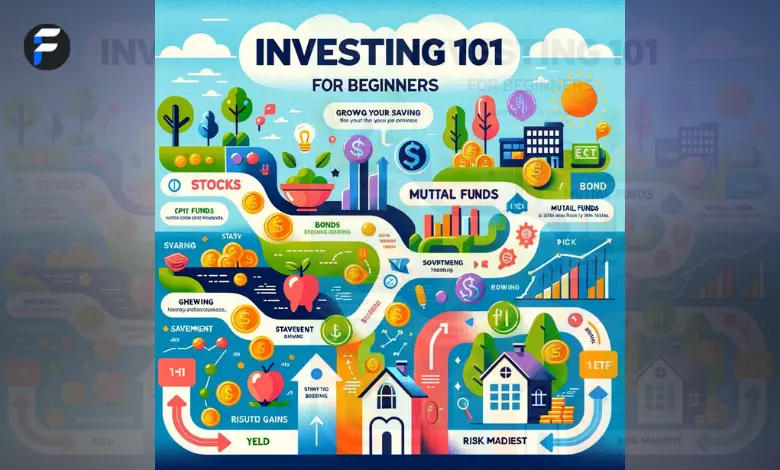
Investing 101 for Beginners
When first starting out on your financial journey, the world of investing 101 for beginners can feel overwhelming. There are so many different options, terms, and strategies to understand that it’s easy to feel lost about where to even begin. As someone just dipping their toes into the world of growing their savings through the markets, you may have a lot of questions about the basics of investing 101 for beginners.
Where To Start
For many people just starting out on their financial journey, the world of investing 101 for beginners can seem overwhelming. There are so many options and things to consider! In this article, I’ll break down some of the basics to get you started on your path to building long-term wealth through investing 101 for beginners.
Set Your Goals
Before putting any money to work, it’s important to take some time to think about your financial goals. Are you saving up for a house? Planning for retirement? Just wanting to get in the habit of growing your savings? Jotting down specific goals with timelines will help you determine the right type of investing 101 for beginners strategy for your situation. Are you looking for short-term gains or willing to ride the ups and downs of the market for decades? Knowing your goals keeps you focused on what really matters.
Choose Your Investment Type
With goals in mind, now it’s time to pick the type of investment that makes the most sense. Some popular options for investing 101 for beginners include stocks, bonds, and mutual funds. Stocks basically represent tiny shares of ownership in companies that can gain value over time.
Bonds are loans you make to companies or governments that pay you interest. Mutual funds are pre-made portfolios that invest in many stocks and/or bonds within a specific category. For investing 101 for beginners, starting with low-fee index funds or ETFs (exchange-traded funds) in a tax-advantaged retirement account is usually the way to go for set-it-and-forget-it growth.
Start Small And Add Regularly
Don’t feel like you need a ton of cash to get started with investing 101 for beginners. Many brokers nowadays allow you to build a diversified portfolio for just a few dollars. Set up automatic contributions from each paycheck, no matter the amount, to develop a regular habit. Whether it’s $25, $50 or $100 each month – it all adds up over the long haul through the power of compound interest. Consistency is key, so aim to contribute on a schedule even during life’s ups and downs.
Be Patient And Ignore The Noise
The hardest part about investing 101 for beginners is not looking at your balance every day and panicking over short-term fluctuations. The market does not go up in a straight line. There will be dips, and that’s normal. As long as you have many years until needing the money and your portfolio matches your goals and risk tolerance, try to relax through the inevitable bumpy periods. Don’t bail out at the bottom only to miss the rebound. Turn off financial news alerts if you must. The name of the game is patience.
Rebalance And Reallocate As Needed
As the years roll on, it’s a good idea to periodically check that your investment mix still aligns with your goals and risk tolerance. This process is called rebalancing. For example, say you started with a 60% stock/40% bond allocation for investing 101 for beginners but stocks have had great gains, shifting you to 70% stocks.
You’d then sell some of the stock holdings and buy more bonds to shift back to the desired 60/40 mix. Rebalancing ensures you don’t get too aggressive as you get closer to needing the money. You may also want to reallocate to less volatile options over time. Checking in annually is usually sufficient for investing 101 for beginners.
Keep Learning Along The Way
Financial education should be a lifelong pursuit. As you gain experience actually putting investing 101 for beginners principles into practice, you’ll learn even more about successful long-term investment strategies. Consider taking occasional online courses or reading investment books to sharpen your skills over decades. Learning from both successes and failures can make you a savvier investor capable of navigating all kinds of economic landscapes. Staying informed will serve you well as the markets and your needs change.
Final Thought
I hope this high-level overview of investing 101 for beginners gives you a solid starting point for beginning your investment journey. Taking small, regular steps like the ones outlined above is the best way to build wealth over the long-run. Remember to always keep your risk tolerance and goals in mind. Wishing you the best of luck as you get started – you’ve got this!
Faqs
What’s the difference between stocks, bonds, and mutual funds?
Stocks represent ownership in companies, bonds are loans, and mutual funds are pre-made portfolios that invest in a mix of many stocks and/or bonds.
How much money do I need to get started?
Many brokers nowadays allow you to build a diversified portfolio for just a few dollars through automated investments. Every little bit adds up over time.
What if the market goes down after I invest?
Short-term fluctuations are normal and to be expected. As long as your investment matches your goals and time horizon, stay calm and avoid panic moves.
How do I know my risk tolerance?
Consider how you’d feel if there was a big dip right after investing. If you’d lose sleep, you may want to choose more conservative options. Take risk surveys online too.
Should I invest on my own or get an advisor?
For simple goals like retirement, low-cost index funds are all many need. But an advisor can provide guidance tailored to your unique situation if you prefer extra help.




